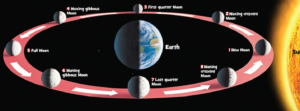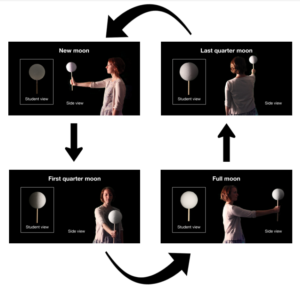Do you ever just look at the moon & say to it “Wait you weren’t like this a few days back, did you just change shape?” Well, we have all at some point been amazed at how the moon appeared to go from nothing to a thin ‘C’, to a semicircle, to a BIG FAT ‘O’.
So, let’s dive in & see what our moon is up to!
MOONLIGHT OR SUNLIGHT?
Firstly, you can let go of the idea of the moon changing shape, The moon is a celestial, spherical body, of fixed dimensions, which is in constant motion around the Earth and the reason it “appears” to change shape is actually the fact that the moon does not produce light of its own, it merely reflects our sun’s light back to Earth.
So, when you look up at the moon, and you notice how it lights up the night sky with it’s “moonlight”, that light is actually the sun’s light, hitting the moon’s surface and getting reflected towards you. The moon is kind of like a mirror in the night sky, trying to sneak in some of the sun’s light onto you, while you are on the dark side, away from the bright sun.
MIRROR MIRROR IN THE SKY
So now that we know that the moon is essentially just kind of like a “mirror” reflecting the sun’s light on us, we can see how it “appears” to change its shape. The phases of the moon are just a simple consequence of how much of the surface of the moon is illuminated by the sun on a particular night.
The three musketeers, the sun, the moon & the earth, are in constant motion relative to each other at all times. The sun sits at the center of the solar system, the Earth goes around the sun, while the moon goes round the Earth!
(28).jpg)
(Source: https://media.proprofs.com/images/QM/user_images/2503852/New%20Project%20(78)(28).jpg)
As the moon moves between the Earth & the sun, the amount of area that:
- receives sunlight
- And is also visible to us from the Earth
varies continuously and it is this variation that leads to the phases of the moon..
PHASES OF THE MOON
So, now that we know how the moon moves relative to the Earth & the sun, and how it reflects the sun’s light, let’s see how our beautiful moon goes from a shining bright circle to complete darkness every month.
The moon completes one cycle around the Earth every 28 days. This means it goes from full moon to new moon & back to full moon, in 28 days.
When the moon is right in between the sun & earth, we cannot see it’s bright side, since it is facing away from us, towards the sun, so that is your “New Moon”, complete darkness as no light can be reflected from the moon, to you.
When it completes half an orbit from “New Moon” position, it is now away from both the sun & the Earth, Now imagine you are standing on the dark side of the Earth, the sunlight would fall on the moon & be reflected back to you, you would see the complete circle, the “Full Moon”.
When half the side of the moon facing earth is lit up, these phases are called first and third quarters.
When the visible lighted surface seems to be getting bigger, we say the moon is waxing, & when it seems to be getting smaller, we say the moon is waning. Also, when more than half of the visible moon is lit, we call it gibbous & when less than half of it is lit up, we call it crescent.

(Source: https://www.natgeokids.com/wp-content/uploads/2018/05/Phases-of-the-Moon-Orbit.jpg)
So, that was all about how the moon “appears” to change shape. Remember, it doesn’t, it’s just a matter of how much of its surface is lit by sunlight and how much of that lit surface you can see at a time.
TRY AT YOUR HOME
Here is an interesting experiment from the wonderful team at NASA, which you can do at home to understand how all this works.
- Use a pencil & a styrofoam ball for the setup, fix the ball on the pencil.
- Go into a dark room & set up a source of light, a bulb, or a lamp.
- Stand in front of the lamp, holding the pencil upright in your hand.
The light source is now the Sun, the ball is the Moon, and you are the Earth.
Now rotate while standing in your place, you would see how the ball would enact the phases of the moon.

(Source: https://www.jpl.nasa.gov/edu/teach/activity/moon-phases/)
Have Fun!
1 - 1Share

